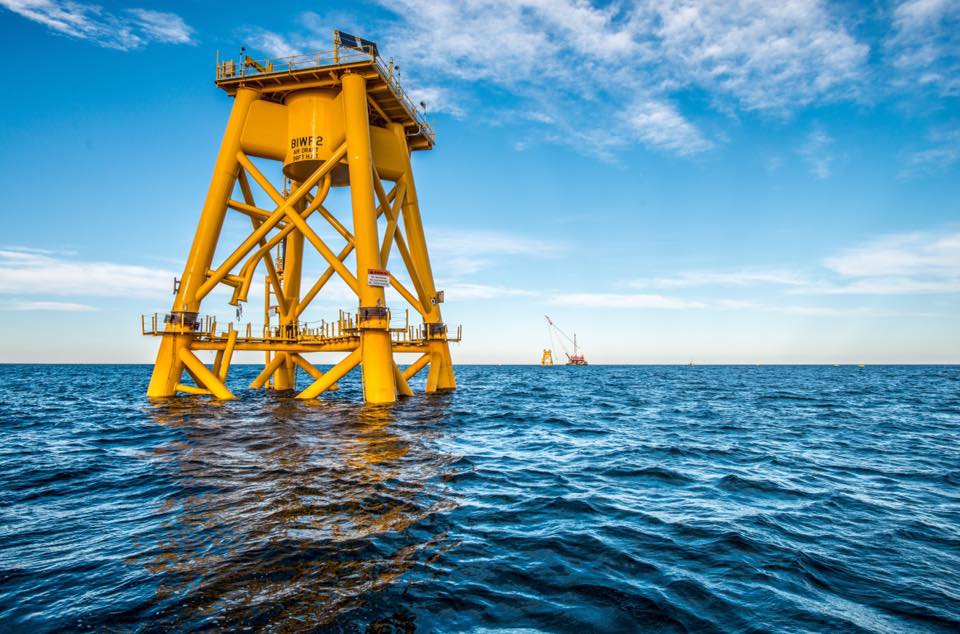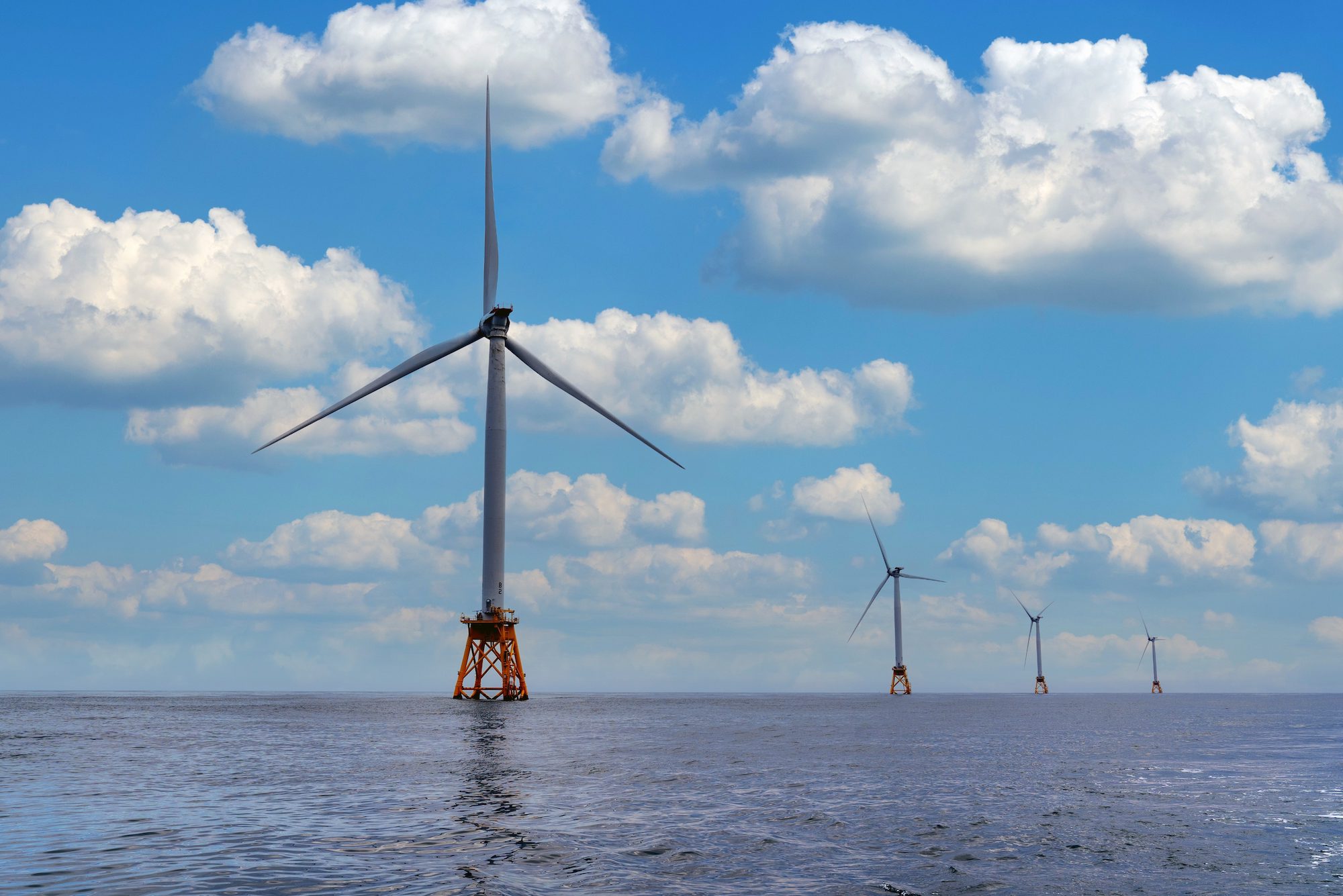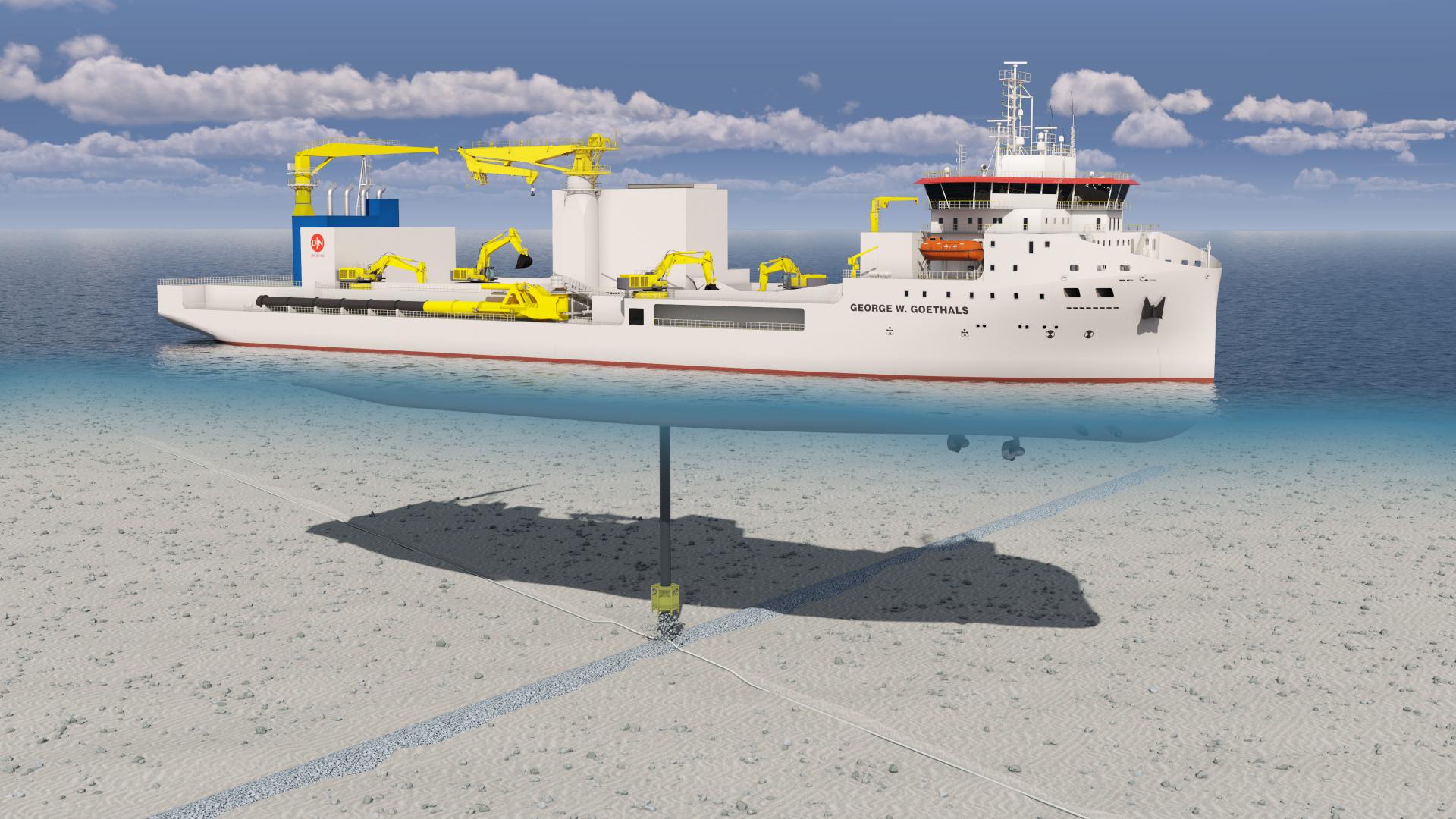One of five jacket foundations installed at Deepwater Wind’s Block Island Wind Farm site, the first offshore wind farm in the U.S.. Credit: Deepwater Wind
 By Christoph Steitz
By Christoph Steitz
FRANKFURT, Sept 23 (Reuters) – Yield-hungry investors in the offshore wind market are switching their sights to the United States as future support for the industry in Europe remains uncertain, leaving billions of euros looking for a new home.
The shift in focus comes as three states on the U.S. east coast — Massachusetts, New Jersey and New York — are auctioning leases on hundreds of thousands of acres for offshore wind farms, drawing interest from leading European companies.
Europe has led the way in developing offshore — the most expensive form of renewable energy — but few of the continent’s cash-strapped governments have given firm plans for support beyond 2020 for a sector still dependent on subsidies.
Putting turbines that stretch 200 metres into the sky in waters 50 metres deep, miles out in stormy seas, is a costly business. New farms take years to plan and build but European governments want to wean developers off subsidies to try to drive down prices.
Despite the cost and complications, American states are tapping into a clean and plentiful source of energy sitting on their doorstep.
A growing U.S. sector would prove another market for investors and equipment makers such as DONG Energy, Germany’s Siemens and Denmark’s Vestas.
In need of at least 1 billion euros ($1.1 billion) of investments each, offshore farms are bigger, benefit from stronger winds and raise fewer environmental protests than those located on land.
They can also generate low double-digit returns for the owners who are prepared to take the initial risk of funding them, according to renewable finance specialist Green Giraffe.
“Many players have cast an eye on the U.S. market,” said Udo Schneider, director at Green Giraffe, which helped to fund more than 35 offshore farms worldwide, including Block Island off Rhode Island, the first such site in the United States.
“Investors are looking for an alternative to Europe.”
EUROPE SETS THE PACE
Having developed a global edge in technology and supply chain management, Europe’s offshore wind industry has attracted 60 billion euros since 2010, lifting capacity to 11.5 gigawatts (GW), more than 90 percent of the world’s total.
One gigawatt is roughly the capacity of a nuclear plant.
A further 12 GW, including the huge Hornsea project off the coast of northern England, is expected to be added by 2020 but uncertainty over how the sector will be supported beyond that is already hitting investment.
After raking in a record 14 billion euros in the first half of 2016 alone, industry group WindEurope expects spending to drop to just 5.2 billion by July 2017.
Major players are already expanding outside Europe, with asset manager Copenhagen Infrastructure Partners (CIP) buying a 675-square-km offshore lease south of Massachusetts last month, where it expects to build a 400 megawatt (MW) site.
In Europe, CIP holds stakes in biomass plants and wind assets in Britain, a converter station that connects offshore parks in the North Sea with the mainland, as well as wind projects off the coasts of Scotland and Germany.
“It’s natural to look for growth outside Europe. I think the U.S. east coast is very interesting. It has a high population and strong winds, which is crucial to offshore,” said Christina Grumstrup Sorensen, senior partner at CIP.
An energy bill passed in Massachusetts last month meant investors now had a good reason to enter the market, she added, declining to say how much CIP had paid for the lease.
Under the law, utilities are required to take 1.6 GW of offshore wind power by 2027, the biggest commitment made so far to the industry in the United States.
“Overall there is potential for more than 5 GW in Massachusetts,” said Martin Neubert, chief strategy officer of wind power at Denmark’s DONG Energy, which has built more than a quarter of the world’s offshore wind farms and holds a 1 GW lease in the U.S. state.
DONG also this year bought a lease to build 1 GW of capacity off New Jersey.
It is still pondering whether to bid for a lease in New York to be auctioned later this year, which could hold up to 700 MW of offshore capacity and has caught the eye of rival investors, including French utility EDF.
BUILDING BLADES
The industry argues it needs substantial volumes to bring down the costs for offshore from around 125 euros per megawatt hour (MWh).
It is unclear whether Europe will commit to the 4-7 GW per year the industry says is needed from 2021 to bring average costs below 80 euros per MWh — a level where it can compete with conventional energy sources, such as coal.
Recent tenders in the Netherlands and Denmark, won by DONG and Sweden’s Vattenfall, suggest that the industry is capable of cutting costs to such levels, but the projects feature unique conditions and do not include costly network connections.
Based on current commitments — including those from Britain and Germany, the two largest offshore wind markets — European demand is expected to grow by only about 2 GW annually during the next decade.
Sam Arie, who leads European utilities research at UBS, said the U.S. offshore market could contribute 1-2 GW of capacity in the medium term, adding existing industry players would be best placed to benefit from this.
“In the first phase we would expect DONG and its partners to play at least some kind of role – you wouldn’t expect the U.S. to be re-inventing the supply chain from scratch,” he said.
This would also benefit Siemens and MHI Vestas — a joint venture between Japan’s Mitsubishi Heavy Industries and Vestas — which together hold more than 80 percent of the global offshore wind turbine market.
Siemens, by far the market leader with more than 7 GW of installed offshore wind turbine capacity, expects large scale projects to materialise in the next decade and “stands ready” to support the U.S. sector, it said in emailed comments.
There is a catch and a cost.
Since most of the production is still based in Europe, the likes of Vestas, Siemens and General Electric would need to set up production of sea-bound turbines along the east coast.
Even though they have a strong presence in the country’s onshore market, offshore turbines are much bigger and more difficult to transport, Macquarie analyst Gurpreet Gujral said.
“I don’t see them shipping blades over the Atlantic.” ($1 = 0.8973 euros)
(Additional reporting by Nichola Groom in Los Angeles and Scott DiSavino in New York; Editing by Keith Weir)
(c) Copyright Thomson Reuters 2016.

 Join The Club
Join The Club











